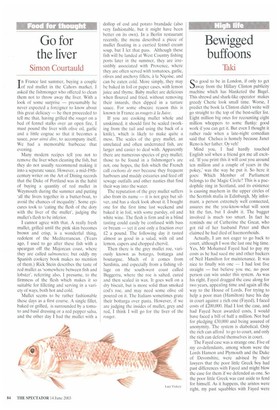Go for the liver
Simon Courtauld
In France last summer, buying a couple of red mullet in the Cahors market, I asked the fishmonger who offered to clean them not to throw away the liver. With a look of some surprise — presumably he never expected a foreigner to know about this great delicacy — he then proceeded to tell me that, having grilled the rouget on a bed of fennel stalks over an open fire, I must pound the liver with olive oil, garlic and a little cognac so that it becomes a sauce, pour ainsi dire, to accompany itself. We had a memorable barbecue that evening.
Many modern recipes tell you not to remove the liver when cleaning the fish, but they do not usually recommend making it into a separate sauce. However, a mid-19thcentury writer on the Art of Dining records that the Duke of Portland was in the habit of buying a quantity of red mullet in Weymouth during the summer and putting 'all the livers together in a butter-boat, to avoid the chances of inequality'. Some epicures took to 'eating the flesh of the dory with the liver of the mullet', judging the mullet's flesh to be inferior.
I cannot agree with that, A really fresh mullet, grilled until the pink skin becomes brown and crisp, is a wonderful thing, redolent of the Mediterranean. (Years ago, I used to go after these fish with a speargun off the Majorcan coast, where they are called salmonetes; but oddly my Spanish cookery book makes no mention of them.) Rick Stein describes the taste of red mullet as 'somewhere between fish and lobster', referring also, I presume, to the firmness of the flesh which makes it so suitable for filleting and serving in a variety of ways, both hot and cold.
Mullet seems to be rather fashionable these days as a first course. A single fillet, baked or grilled, is surrounded by a tomato and basil dressing or a red pepper salsa, and the other day I had the mullet with a dollop of cod and potato brandade (also very fashionable, but it might have been better on its own). In a Berlin restaurant recently, the menu described a piece of mullet floating in a curried fennel cream soup, but I let that pass. Although these fish will be landed at West Country fishing ports later in the summer, they are irresistibly associated with Provence, where they are often served with tomatoes, garlic, olives and anchovy fillets, a la Nicoise, and can be eaten cold. More simply, they may be baked in foil or paper cases, with lemon juice and thyme. Baby mullet are delicious when floured and fried, without removing their innards, then dipped in a tartare sauce. For some obscure reason this is known in France as rougets a la Juive.
If you are cooking mullet whole and unskinned, it should first be scaled (working from the tail and using the back of a knife), which is likely to make quite a mess. The scales of the grey mullet, an unrelated and often underrated fish, are larger and easier to deal with, Apparently there are numerous species of grey mullet; those to be found in a fishmonger's are not, one hopes, the fish which the French call cochons de mer because they frequent harbours and muddy estuaries and feed off sewage outfalls and other nasties that find their way into the water.
The reputation of the grey mullet suffers also from its name — it is not grey but silver, and has a sleek look about it. I bought one for the first time last weekend and baked it in foil, with some parsley, oil and white wine. The flesh is firm and in a blind tasting could easily be confused with bass or bream — yet it cost only a fraction over £2 a pound. The following day it tasted almost as good in a salad, with oil and lemon, capers and chopped chervil.
Then there is the grey mullet roe, variously known as botargo, bottarga and boutargue. Much of it comes from Sardinia, and especially from a fishing village on the south-west coast called I3uggerru, where the roe is salted, cured and then sealed in wax. It goes well on a dry biscuit, but is more solid than smoked cod's roe, and may need some olive oil poured on it. The Italians sometimes grate their bottarga over pasta. However, if we are judging the insides of mullet, grey and red, I think I will go for the liver of the rouget.


































































































 Previous page
Previous page